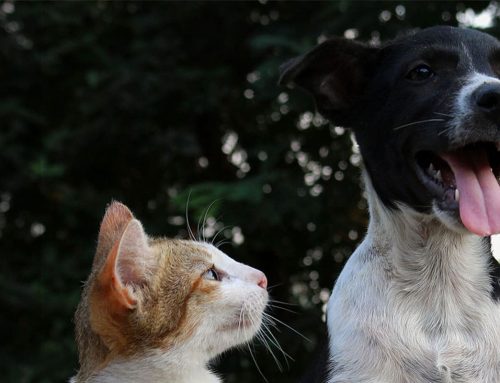Pets are Similar to Humans
Like humans, the occurrence of allergic reactions in pets is increasing. Allergic reactions in pets are often indicated by skin problems, excessive itching and scratching. Allergies which affect dogs are of three main types:
- Flea allergy dermatitis;
- Environmental allergy; and
- Food allergy.
Pets may be affected by more than one type of allergy.
Environmental Allergy
Define Environmental Allergy and the Signs
Environmental allergy is also referred to as ‘Atopy’. It is a sensitivity reaction induced by substances present in air like pollens, moulds, dust mites and animal fur. The incidence of Atopy depends as much upon a pet’s genetic susceptibility as exposure to the allergen itself. Terriers, Setters, Retrievers, Dalmatians and Chinese Shar-Pei are among the breeds that are particularly prone to Atopy.
Signs and Symptoms
Main symptoms are itching around the face, feet, lower abdomen area and tummy. Pollen allergies are seasonal, but allergies caused by moulds, dust mites and dander can affect your dog all year round. The allergic sensation can also cause other skin problems and ear infections. Prolonged scratching can lead to hair loss of that area. Normally the signs can first be noticed between the age of 1 to 3 years and the onset may start to show up from 4 months to 7 years.
Diagnosis of Atopy
Your vet will ask you for a detailed history of your pet’s itching problem. This will help your vet rule out other causes of itching like fleas, mites, bacterial, yeast and food allergies. A process of elimination is used and tests are only conducted as a last resort. Laboratory testing for skin or serum (blood) is used to pinpoint the exact cause.
Treatment
Although Atopy is a permanent condition, it can be managed well if you:
- Use only anti-itching shampoos, conditioners and medicines for your pet.
- Avoid allergens by removing them from the living environment as much as possible.
- Administer hyosensitization injections to your pet, so their system can learn to fight the allergens. The responses and effects vary from animal to animal, but this treatment can provide relief in 75% of pets suffering from Atopy.
- Use Elizabethan collars and socks to act as physical barriers to prevent itching and scratching.
Flea Allergy Dermatitis
What is Flea Allergy Dermatitis and what are the Signs?
Flea Allergy Dermatitis (FAD), also called Flea Bite Hypersensitivity, is an allergic reaction caused by flea saliva. A single flea bite can initiate this disease causing intense itching. Dogs suffering from FAD excessively scratch their necks, sides, tummies, inner thighs and area above the tail. The scratching and brushing act is so severe that it results in loss of hair. FAD usually causes hot spots or local skin infections. Fleas and flea waste can be found on dogs in the form of black spots. Dogs suffering from FAD carry fewer fleas due to continuous scratching and licking.
Identification of FAD
Veterinarians diagnose FAD by evaluating the signs such as scratching on skin, sores, and the existence of fleas and flea waste. A skin test may also be recommended because the symptoms of FAD closely resemble to the symptoms of other diseases such as mites and lice attack, parasitic invasion, infections and other ailments that cause itching.
Treatment of FAD
Prevention as they say is the best medicine, and the way to achieve this: avoiding fleas! Here are some simple tips to follow to achieve this:
- Use insecticides and insect growth regulators to eliminate flea infestations;
- Consult the vet to determine which product to use on your pet;
- Reduce flea populations in your home with proper cleaning and vacuuming is recommended;
- Wash pet bedding and coverings frequently;
- Corticosteroids, antihistamines and essential fatty acids are prescribed to crack down the itch cycle that further directs to various skin infections and reduces pain and irritation. These medicines are prescribed by a veterinarian; and
- Bathing with warm water and using anti itching shampoo and conditioner can also help.
Remember there is no treatment for FAD. If infected once, your pet will always be allergic to flea bites so always be ready to protect him from other associated problems.
Food Allergy
What is Food Allergy and what are the Signs?
Allergy to any of the ingredients present in food causes this allergic reaction. The common allergens are beef, dairy products, cereals like corn, wheat and soya, poultry and eggs. The causes that result in food allergy are still not identified, but commonly food allergies can come about because of changes to the immunity of the pet Sometimes ingredients are perceived by your pet’s immune system as foreign, initiating inflammatory mechanisms to fight the intruder.
The general symptoms of food allergy are itching, licking and chewing. Food hypersensitivity is also reported to be associated with skin problems and some pets may also suffer diarrhoea and other digestive problems. Symptoms can appear at any age and time.
Identification of Food Allergy
Food allergy can only be detected by having your pet on a hypoallergenic or exclusion diet for a period of about 8 to 12 weeks. Such diets comprise of ingredients that the pet hasn’t been exposed to before. Most of the food allergic reactions are induced by proteins and many exclusion diets are based on proteins usually fish or duck that are not a part of normal animal food. An exclusion diet comprises of home prepared food rich in proteins or commercially available hypoallergenic products prescribed by the vet.
If your pet is prone to food allergy then the symptoms should decrease considerably after the exclusion diet ceases. The result depends on the allergic response of your animal to the newly introduced diet. To make a proper diagnosis for food allergens, give your animal a single protein meal for 1 to 2 weeks at a similar time, keeping an eye on the appearance and worsening of symptoms. If allergies are reported to be positive than remove the component causing it from the diet. Your vet can help with the correct procedure.
Treatment of Food Allergy
The best and the only way to avoid food allergy is by carefully keeping an eye on your pet’s diet, so it doesn’t reappear. Sometimes your vet may prescribe antihistamine and corticosteroids to combat symptoms.
Insect Allergies
Skin allergic reactions in pets can also be due to mosquito bites and midges. Similar to a flea allergic reaction, the animal is sensitive to the saliva of the insect injected into the body during biting. Prevention is the best way to go about avoiding these allergies, so:
- Make sure there are screens on all windows and doors;
- Eliminate possible breeding spots, e.g. stagnant water; and
- Keep your pet inside during the day, especially at dawn and sunset.




